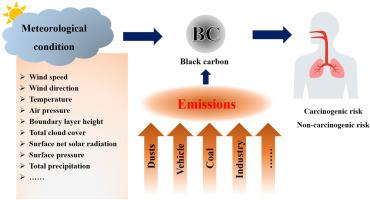济南市城市黑碳变化、健康风险及驱动因素分析
IF 6.3
2区 环境科学与生态学
Q1 ENVIRONMENTAL SCIENCES
引用次数: 0
摘要
大气黑碳对气候变化、大气环境和人类健康具有重要影响。为探讨2021 - 2022年济南市城市不同时期BC浓度的时间变化特征及其对健康的影响,采用蒙特卡罗模拟方法分析了BC浓度特征,并对人群暴露风险进行了评估。此外,我们使用SHapley加性解释解释算法研究了驱动因素对BC的作用。BC浓度在冬季最高(2.40±1.76 μg/m3),夏季最低(1.46±0.89 μg/m3),呈双峰型变化。我们的研究结果表明,BC在冬季对成人的致癌风险超过了可接受的阈值。以排放为主,气象条件对BC也有显著影响,风速、相对湿度和边界层高度是影响BC浓度变化的主要因素。雾霾期间的气象条件有利于BC的积累,PM2.5水平升高的时间与BC浓度高和致癌作用增加有关。了解BC的时间变化和驱动因素对于制定有效的政策来减轻空气污染至关重要。本研究可为研究不同气象条件下的BC水平提供理论方法和实践指导,增强对大气特征和人群暴露的认识。本文章由计算机程序翻译,如有差异,请以英文原文为准。

Black carbon in urban Jinan: Variations, health risks, and driving factors analyzed with machine learning
Atmospheric black carbon (BC) significantly impacts climate change, atmospheric environment, and human health. To explore the temporal variation of BC concentration and its health effects during different periods in urban Jinan from 2021 to 2022, we analyzed BC concentration characteristics and assessed the population exposure risk using Monte Carlo simulation. Additionally, we studied the role of driving factors on BC using SHapley Additive exPlanations interpretation algorithm. A clear temporal trend was observed in BC levels, with the highest BC concentration in winter (2.40 ± 1.76 μg/m3) and the lowest in summer (1.46 ± 0.89 μg/m3), and a bimodal pattern in diurnal variation. Our results indicated that the carcinogenic risk of BC for adults exceeded the acceptable threshold in winter. With emissions playing a dominant role, meteorological conditions also significantly affected BC, with wind speed, relative humidity, and boundary layer height playing major roles in variations of BC concentration. Meteorological conditions during the haze periods favored BC accumulation, hours with elevated PM2.5 levels were associated with high BC concentrations and increased carcinogenic effects. Understanding the temporal variations and drivers of BC is crucial for formulating effective policies to mitigate air pollution. Our study may provide theoretical methods and practical guidance for addressing BC levels under varying meteorological conditions and enhance understanding of atmospheric characteristics and population exposure to BC.
求助全文
通过发布文献求助,成功后即可免费获取论文全文。
去求助
来源期刊

Journal of Environmental Sciences-china
环境科学-环境科学
CiteScore
13.70
自引率
0.00%
发文量
6354
审稿时长
2.6 months
期刊介绍:
The Journal of Environmental Sciences is an international journal started in 1989. The journal is devoted to publish original, peer-reviewed research papers on main aspects of environmental sciences, such as environmental chemistry, environmental biology, ecology, geosciences and environmental physics. Appropriate subjects include basic and applied research on atmospheric, terrestrial and aquatic environments, pollution control and abatement technology, conservation of natural resources, environmental health and toxicology. Announcements of international environmental science meetings and other recent information are also included.
 求助内容:
求助内容: 应助结果提醒方式:
应助结果提醒方式:


